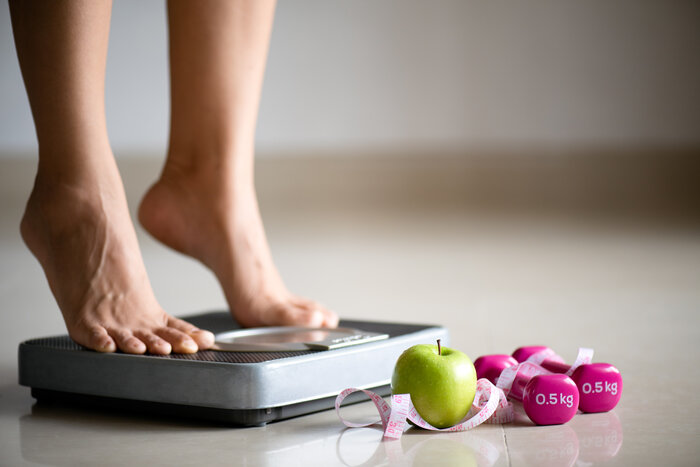Lose Weight Permanently– Without a Diet from Atkins to low carb to the Stone Age Paleo diet Lose Weight Permanently Healthily promise rapid weight loss in a short time. However, a healthy diet and adequate exercise will help you lose weight in the long term.
Table of Contents
Body weight in kg : (height in m)
Alternatively, the Federal Center for Health Education (BzgA) offers one BMI–Rechner for free on their website.

BMI Table
Calculate your BMI easily by entering your height and weight in the table.
- Grey: Your weight is meager; you should not lose any more weight.
- Green: Great! Your weight is in the normal range.A
- Yellow: You are slight too temperately overweight. From a health perspective, this is not a concern to worry about if your blood values and blood pressure are acceptable. However, be careful not to gain any extra weight. Losing some pounds is advisable from a health perception.
- Red: Your body weight is suggestively above average weight. It will be good for your health if you try to lose weight because you may develop a risk of diseases such as high blood pressure, diabetes, or even a stroke. Consult your doctor about how you can lose weight in a healthy way over the long term.
Ten Tips For Losing Weight with The Proper Diet
The DGE recommends long-term weight loss based on a combination of dietary changes, behavioral changes, and increased physical activity. Eating a nutritious diet and exercising 30 to 60 minutes daily will help regulate weight. Do somewhat good for yourself and your body with these ten rules:
1. Eat a Variety of Foods
Combine all food groups, i.e., plant and animal foods and fats. For example, vegetable foods have few calories but are bursting with vitamins, minerals, and fiber.
2. 5 Times Fruit and Vegetables a Day
The vitamins, minerals, and fiber in fruit and vegetables give you energy for the day. Incidentally, this includes legumes such as lentils, chickpeas, beans, and unsalted nuts. The DGE recommends at least three servings of vegetables and two servings of fruit daily.
3. Whole Grain Instead of White Flour
Pasta, bread, and co. made from whole grains provide healthy nutrients, keep you full for longer and reduce the risk of many diseases such as type 2 diabetes mellitus or colon cancer. Potatoes are also a healthy source of carbohydrates.
4. Animal Foods in Moderation
Milk and dairy products provide the body with valuable calcium every day. You can access the fish once or twice a week. Enjoy meat and sausages rarely. Between 300 and 600 grams per week is ideal. Eggs are allowed in moderation, so they should not be on the menu daily.
5. Fat is Important
But please mainly use vegetable oils from rapeseed, walnut, soy, or olives. In addition, I prefer vegetable fat spreads instead of butter. Fat oils such as coconut and palm oil or palm kernel oil can unfavorably affect health.
more on the subject of Lose Weight Permanently Healthily – Without a Diet
Healthy eating, good fats, bad fats: what makes them different?
6. Less Sugar and Salt
Sugar is found primarily in processed foods and sweetened beverages of all kinds. It is, therefore, best to cook freshly and drink plenty of unsweetened beverages such as water and tea. This saves calories and reduces your risk of obesity, type 2 diabetes mellitus, and tooth decay.
High salt levels increase the risk of high blood pressure and cardiovascular disease. It’s often found in sausage, bread, cheese, and mainly processed foods. Instead, try cooking with a bit of salt and not adding more salt to the table. This way, the individual foods taste much more natural.
7. Drink, Drink, Drink – and Do it Right
1.5 liters of water or unsweetened tea quench thirst and leave blood sugar untouched. Cravings don’t stand a chance. If you need a taste, you can mix juice spritzers with a ratio of 3 parts water to 1 part juice. Avoid sugary foods and alcohol.
8. It all Depends on the Preparation
To conserve nutrients and save fat, steaming and stewing food is particularly suitable. The rule is: as long as necessary and as short as possible. However, meat and fish should always be cooked to avoid foodborne contamination.
9. Take Your Time
If you enjoy your food and eat slowly, you get more out of it. Because the feeling of satiety only sets in after about 15 to 20 minutes. So you never eat too much and even support your digestion with thorough, slow chewing.
10. Movement is the Be-all and End-all
In addition to a balanced, healthy diet, body weight can be controlled through regular exercise. Incidentally, this also includes everyday activities such as cycling and climbing stairs.
About 30 to 60 minutes of minimum physical activity daily is suggested. This is because anyone who does sports automatically increases calorie consumption, and the muscles built up also burn calories during sleep. In addition, regular exercise decreases the risk of many diseases, such as cancer, type 2 diabetes mellitus, high blood pressure, stroke, or osteoporosis.
Conclusion:
Consistent aerobic activity, such as brisk walking, for at least 30 minutes most days of the week is one of the greatest strategies to shed body fat. Some people might need more exercise than recommended to reduce their weight and keep it off. Any additional movement aids in calorie burning.

